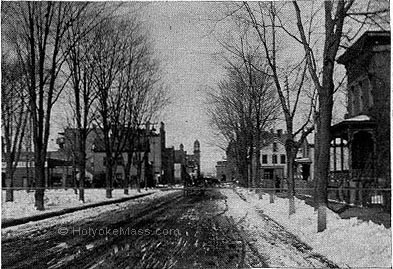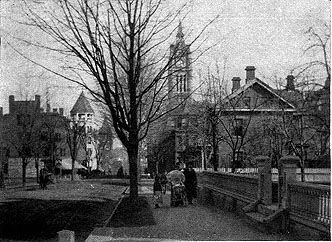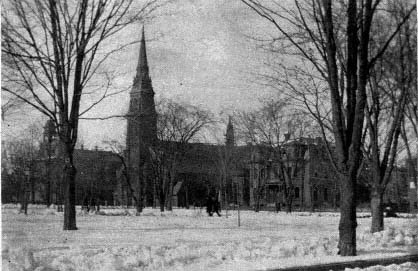In 1847, George C. Ewing, a salesman for the Fairbanks Scale Company of St. Johnsbury, Vt., and who in his journeyings up and down the valley had acquired considerable familiarity with the region, became impressed with the idea that at the South Hadley falls was one of the largest available water powers in the country, going to waste. He interested his employers in the scheme of building a dam here, and shortly had bought up 1,100 acres of land on the present site of Holyoke. The total amount of acres was afterwards increased to 1,500. Large prices were paid for the land, if viewed from a farming standpoint, which had previously been the land’s only claim to worth; but from a manufacturing standpoint, the prices were extremely moderate. Five thousand dollars, at the time the dam was completed, would have bought fifty acres right in the best part of the present city. Most of the farmers were ready enough to sell at the prices offered, and the only one with whom any trouble was had was with Sam Ely, who had an eighty acre farm on the river-side, some distance below the proposed dam. Half he sold, but at the rest he clung to. He was an old-fashioned farmer, who had an antipathy to innovations, and he wished to keep the old homestead on which he had been brought up and where he had always lived. Besides, he said he didn’t want to see the corporations control everything, and he was sorry they had come there. “He didn’t s’pose he could raise nothing now; it’d all be stolen.” But the company wanted the land, and they kept after him. "Uncle" John Chase was their emissary in this matter. Finally Sam got sick of the harassing and one day, seeing Uncle Chase approaching on his usual errand, he raised his chamber window and poked the muzzle of his old gun over the sash, and warned Uncle Chase to come no nearer or he would shoot. Uncle Chase thought this an idle threat and kept right on, and Ely pulled the trigger. The musket was heavily loaded, and the discharge was quite startling. The visitor was not hurt, but he was well scared, and made haste to retreat. This event was the sensation of the town for some time. There was talk of arresting Ely; but this was not considered politic, as anything to disturb him would put off the day of securing the land. The wisdom of this course was proved, when a little later the desired transfer was made.
 The City Hall Viewed Across Hampden Park.
The City Hall Viewed Across Hampden Park.
|
Meanwhile the Fairbanks had sold out to a Boston company, and work on the dam at once commenced. This project of constructing a dam on the Great rapids—which should withstand the powerful current of the Connecticut river and afford motive power for a new city of mills and shops—was so gigantic, and the capital to be invested was so large for those days, that the undertaking was famous from its inception and still ranks among the foremost manufacturing enterprises of the world. When the dam was completed and a day was set for testing it, crowds of people came from all the country about to observe this new marvel, and, I suppose, to "see how it would work." It had much the appearance of the rude horse-sheds we see behind the country churches, being a hollow framework of timbers, with a roof slanting up stream. There were those who scoffed at the new structure, and one man drew a line on it with a bit of chalk, and maintained that when the water rose to that point the whole thing would give way. Others affirmed that it was as stale as the rock itself beneath, and one excited citizen declared that “God Almighty couldn’t sweep it away.” The gates were closed in the morning, and many people, as the waters slowly rose, walked back and forth on top of the dam or jumped about on the dry rocks of the ricer bed below. But in the afternoon, the dam sprung aleak, and the people were warned back to the banks. Then it was seen that the great stone bulkhead at the west side showed signs of weakening. It was evidently going to tip over. In case it did, the vast body of water collecting above would sweep through the village below and destroy everything in its path. Quantities of railroad iron were brought and piled upon the bulkhead in great haste; but while this work was going on there was a crack in mid-stream, and the whole dam, save a little at each shore, was seen tipping over and crumbling before the pent-up waters of the river. A mighty wave rushed and roared over the ragged rocks of the river bed, and spent itself far below on the South Hadley shore. The water was full of broken timbers, tossing about in the surging torrent, and these seemed to the excited crowds on shore to be struggling human beings. It was a terrible sight. Every house in the village, on the Holyoke banks, was emptied of its occupants, and for the moment each who had friends or relatives among the laborers were sure they were lost.
 Dwight Street, Near High.
Dwight Street, Near High.
|
 St. Jerome’s Catholic Church.
St. Jerome’s Catholic Church.
|
© Laurel O’Donnell 1996 - 2006, all rights reserved
This document may be downloaded for personal non-commercial use only
and may not be reproduced or distributed without permission in any format.
This is an edited adaptation from the original publication.
|